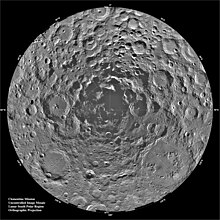Although liquid water cannot persist at the Moon's surface, and water vapour is quickly decomposed by sunlight and lost to space, scientists have thought since the 1960s that water ice, deposited by impacting comets or produced by the reaction of oxygen-rich lunar rocks and hydrogen in the solar wind, could survive in the cold, permanently shadowed craters at the Moon's poles.[56] These craters have been in shadow for the past two billion years,[57] and computer simulations suggest that up to 14,000 km2 might be in permanent shadow.[58] The presence of usable quantities of water on the Moon is an important factor in rendering lunar habitation cost-effective, since transporting from Earth would be prohibitively expensive.[59]
Many different signatures of lunar water have since been found.[60] In 1994, Clementine's bistatic radar experiment found indications of small, frozen pockets of water close to the surface (though later Arecibo radar observations suggested these might be rocks ejected from young impact craters);[61] the Lunar Prospector's neutron spectrometer indicated in 1998 that high



0 comments:
Post a Comment